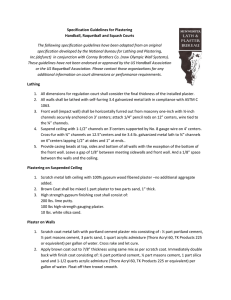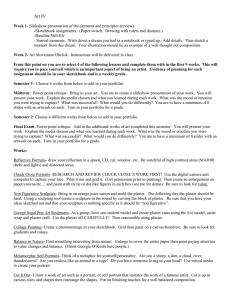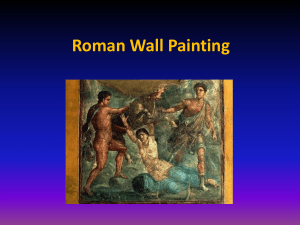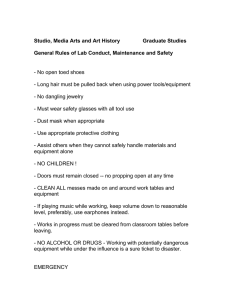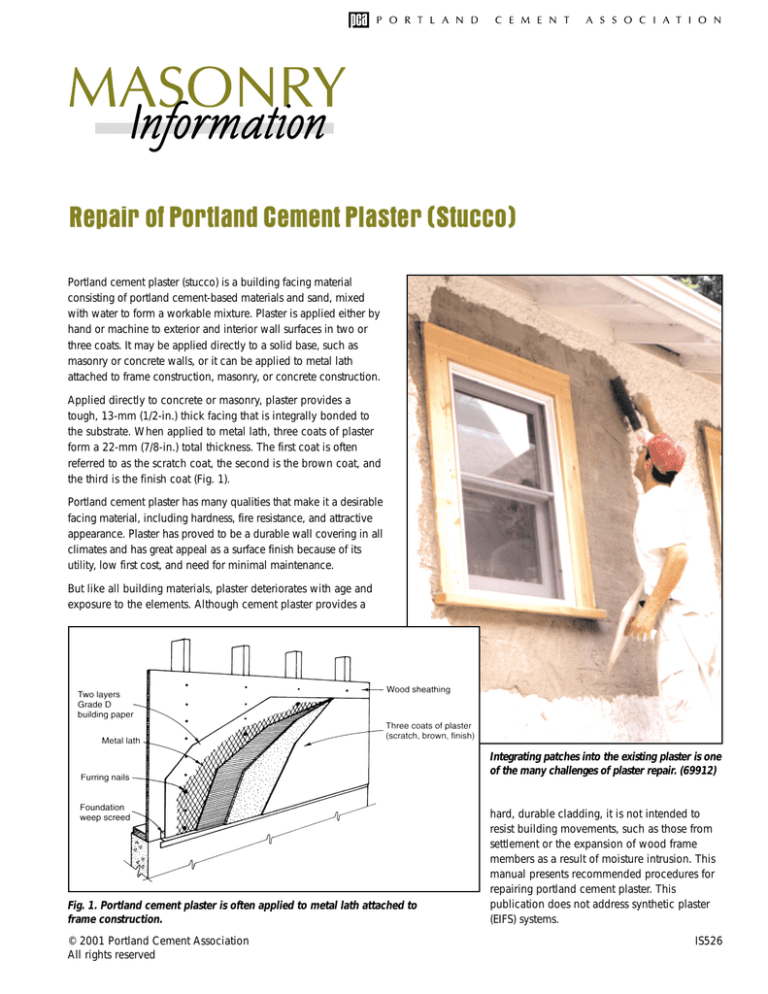
Repair of Portland Cement Plaster (Stucco)
Portland cement plaster (stucco) is a building facing material
consisting of portland cement-based materials and sand, mixed
with water to form a workable mixture. Plaster is applied either by
hand or machine to exterior and interior wall surfaces in two or
three coats. It may be applied directly to a solid base, such as
masonry or concrete walls, or it can be applied to metal lath
attached to frame construction, masonry, or concrete construction.
Applied directly to concrete or masonry, plaster provides a
tough, 13-mm (1/2-in.) thick facing that is integrally bonded to
the substrate. When applied to metal lath, three coats of plaster
form a 22-mm (7/8-in.) total thickness. The first coat is often
referred to as the scratch coat, the second is the brown coat, and
the third is the finish coat (Fig. 1).
Portland cement plaster has many qualities that make it a desirable
facing material, including hardness, fire resistance, and attractive
appearance. Plaster has proved to be a durable wall covering in all
climates and has great appeal as a surface finish because of its
utility, low first cost, and need for minimal maintenance.
But like all building materials, plaster deteriorates with age and
exposure to the elements. Although cement plaster provides a
Integrating patches into the existing plaster is one
of the many challenges of plaster repair. (69912)
Fig. 1. Portland cement plaster is often applied to metal lath attached to
frame construction.
© 2001 Portland Cement Association
All rights reserved
hard, durable cladding, it is not intended to
resist building movements, such as those from
settlement or the expansion of wood frame
members as a result of moisture intrusion. This
manual presents recommended procedures for
repairing portland cement plaster. This
publication does not address synthetic plaster
(EIFS) systems.
IS526
Portland Cement Association
Causes of Plaster
Damage
Portland cement plaster can deteriorate for a variety of reasons,
including inadequate design
details, poor installation, or the use
of improper materials. In many
cases, damage results from water
infiltration into the building
structure either through cracks,
through the roof, around
chimneys, or through window and
door openings. Water that gets
behind the plaster can cause wood
lath to rot and metal lath and nails
to rust, and can cause plaster to
delaminate from the substrate.
Cracking in plaster is usually
shrinkage-related or the result of
external loads, such as ground
Fig 2. Improper curing of plaster can result in map cracking. (69914)
settlement or inadequate stiffness
of the backing. Common causes
repairing the plaster. These may include roof, gutter, downspout,
of cracking are improperly placed control joints, improper lath
and flashing repairs. Horizontal areas, such as the tops of parapet
installation, and inadequate curing.
walls or chimneys, are particularly vulnerable to water
Control joints are provided in plaster to relieve drying shrinkage
infiltration. These areas may require modifications to their
stresses and to provide stress relief in areas subjected to
original design, such as the addition of flashing (Grimmer 1990).
movement, such as window and door openings. Drying
shrinkage cracks are often caused by violating the rules of
control joint spacing (ASTM C 1063):
Identifying Damaged Plaster
• Each continuous vertical area should be no more than 13.4 m2
(144 ft2).
• Distance between joints should be no more than 5.5 m (18 ft)
in any direction.
• No panel should have a length-to-width ratio greater than
2-1/2 to 1.
• Joints should be positioned at movement joints in the substrate.
In wood-frame plaster construction, metal lath expands and
contracts with the surrounding plaster. If lath is installed
incorrectly, sufficient tensile stresses can develop within the
plaster to cause it to crack. Rules for lath installation include:
• Lath should not be continuous at control joints.
• Lath should be lapped 13 mm (1/2 in.) at the sides and
25 mm (1 in.) at the ends (ASTM C 1063), with wire ties
spaced 230 mm (9 in.) apart.
• If paper-backed lath is used, laps should be installed to allow
a paper-paper and lath-lath lap.
Freshly placed plaster must be protected from excessive moisture
loss in the first few days after application. Otherwise, early
shrinkage of the plaster can result in map cracking (Fig. 2).
After the cause of deterioration has been identified, any
necessary repairs to the building should be made before
2
Fig. 3. Water-damaged plaster often
bulges or falls away from the building.
(69906)
Before beginning any
repair, the plaster should
be evaluated to determine
the extent of damage and
how much must be
repaired or replaced.
Some areas in need of
repair are obvious, such
as missing sections or
layers of plaster (Fig. 3).
Water-damaged plaster
often bulges or falls away
from the building because
excessive moisture causes
the coats of plaster to
delaminate and the metal
lath and nails to rust.
Unsound or soft areas that
have delaminated will
make a hollow sound
when tapped with
a hammer.
Petrographic examination and chemical analysis (ASTM C 1324)
of samples of the plaster can determine its mix components and
can provide other relevant information, such as the quality of the
bond between coats. This information can offer clues as to the
a
Repair of Portland Cement Plaster (Stucco)
expected useful life of the plaster that remains and aid in
determining the appropriate scope of the repair project.
Plaster Removal
Plaster that has
delaminated from the
base, but is otherwise
sound, may require a saw
or diamond grinder to be
removed. Soft or crumbled
plaster can usually be
removed with a chisel or
other hand tool (Fig. 4).
If the plaster is properly
keyed into the lath, the
lath may have to be cut as
well. In these cases, sound
plaster at the patch
perimeter will have to be
removed to make room for
lapping the new and
existing lath.
When patching the
plaster, replace it in
layers to the same
thickness as the existing
plaster. Therefore, each succeeding coat is cut back further than
the preceding one, the base coat being the smallest area, and the
finish coat being the largest area to be patched (Fig. 5).
Fig. 4. Soft or crumbled plaster can
usually be removed with a chisel or
other hand tool. (69907)
If matching the color and texture of the existing plaster is critical,
one option is to use abrasive blasting to remove the finish coat of
the plaster surrounding the patch. Then the patch and
surrounding areas share the same finish coat upon reapplication.
Lath and Paper Repair
If the existing building paper is torn, it should be replaced with
new paper that meets the requirements of UU-B-790a, Federal
Specifications for Building Paper, Vegetable Fiber (Kraft,
Waterproofed, Water Repellent, and Fire Resistant). Slip the new
paper behind the existing paper at the top and sides and allow it
to extend over the old paper at an existing lap. Laps should be at
least 100 mm (4 in.). This will help prevent water that gets
behind the plaster from running down behind the paper.
Corroded or otherwise damaged lath should be cut out and
replaced with a new section of lath conforming to ASTM C 847.
Follow the lath lapping guidelines outlined above. Also, if using
lath that comes pre-attached to a paper backing, you must
separate the lath from the paper so the existing building paper is
in contact with the new paper and the existing lath is in contact
with the new lath. Anchor the new lath to studs at no more than
180 mm (7 in.) on center, but avoid nailing the lath to the
substrate between the studs. Doing so prevents the lath from
expanding and contracting with the plaster, which can cause
cracking. Instead, wire-tie the new and existing lath.
Surface Preparation
Masonry or concrete substrates usually require preparation to
ensure that the plaster establishes a strong bond. These surfaces
should be sandblasted or mechanically abraded to remove
contaminants and roughen the surface to maximize the bonding
area of the new plaster. However, don’t rake out masonry mortar
joints to provide a “key.” Doing so will create plaster of varying
thickness, which can cause cracking.
a
If the masonry or concrete is dry, dampen the surface to prevent
it from absorbing an excessive amount of water from the plaster.
The prepared substrate should be at, or slightly drier than, a saturated, surface-dry
(SSD) condition.
Finish coat
Brown coat
Scratch coat
The same rules that
apply for a masonry
or concrete substrate
also apply for the
edges of the existing
plaster to which
the patch material
will bond. The
edges of the existing
plaster should be
roughened and
properly dampened.
Metal lath
Building paper
Fig. 5. When patching plaster, each succeeding coat is cut back
further than the preceding coat, the base coat being the smallest area
and the finish coat being the largest area to be patched.
Figure 6. Applying a bonding agent
can improve adhesion to the substrate
and existing plaster. (69908)
Although plaster
should bond well to a
properly prepared substrate, bonding agents
can also be used
(Fig. 6). All bonding
agents should conform
to ASTM C 932.
3
Portland Cement Association
Patch Application
The same techniques used to apply plaster in new construction
are used in repair and are outlined in ASTM C 926. Apply the
scratch coat at the same thickness as the surrounding scratch
coat and with enough pressure to completely embed the metal
lath (when present). As soon as the scratch coat becomes firm,
score the surface in one direction only. Vertical wall surfaces
should be scored horizontally.
After allowing the scratch coat to cure for at least 24 hours,
apply the brown coat at the same thickness as the existing brown
coat. Follow the same rules for applying the finish coat.
Curing Patches
Proper curing of patches is essential to avoid rapid water loss
from the plaster, which can lead to cracking and debonding of
the patch material from the surrounding plaster. Wind, high
temperatures, and exposure to direct sunlight will accelerate
water loss from the plaster. Curing procedures should maintain a
relative humidity of 80% for at least 24 hours, and up to 7 days
in some cases.
The plaster can be moist-cured by periodically applying a fine
fog spray of water to the surface. But perhaps the most practical
curing method is to install plastic film around the repaired area.
Consider using an opaque film to protect the plaster from
sunlight. Place the film as soon as the plaster surface has
hardened enough to resist impression by contact with the film.
Crack Repair
To decide if (and how) a crack should be repaired, you must
determine the cause of the crack and consider the consequences
if the crack is not repaired. Most repair techniques make cracks
Continued on page 6
Fig. 7. A crack movement monitor is a useful tool for
determining if a crack undergoes movements that are greater
than would be expected from normal thermal cycling. (69913)
4
Selecting a Patch Material
Table 1 shows scratch coat, brown coat, and finish coat mix
proportions that are recommended by ASTM C 926 and have
demonstrated successful performance in service. In many cases,
plaster mixes containing these material proportions will make a
suitable patching material. Latex or acrylic polymer modifiers
may also be added to the mix water to improve plaster
properties. A wide range of colored pigments is also available
for creating colored finish coats. The pigments should conform
to ASTM C 979. In addition, prepackaged plaster materials are
available from several manufacturers.
Selecting an appropriate mix for patching plaster presents two
additional challenges that are not factors in new construction:
(1) matching the color and texture of the existing plaster, and
(2) physical compatibility of the new and existing plaster.
Matching Color and Texture
A common approach to disguising the different appearance of
new and old plaster is to simply apply a coating over the entire
surface. But a coated plaster surface may not be desirable and,
although coatings will hide color differences, they may not
conceal differences in surface texture.
It’s virtually impossible to place plaster patches that blend in
perfectly with the surrounding plaster. Exposure to the elements
results in fading, erosion, and other changes in appearance that
occur only over time. Nevertheless, you can take steps to reduce
the contrast between new and old plaster.
A good place to start is to perform petrographic examination
and chemical analysis (ASTM C 1324) on a sample of the
existing plaster to determine its mix components. In most cases,
you’ll want to use a similar mix for the patch material,
assuming it provides acceptable durability. The texture of
plaster is greatly influenced by the amount and type of
aggregate used in the mix. When choosing materials—
especially for the finish coat—consider using aggregate with the
same size and shape as the existing plaster. Also, colored
masonry cements are available in many regions, or white
portland cement (or a mixture of white and gray portland
cement) can be blended with pigments (ASTM C 979) to match
colored plaster. After materials are chosen, a skilled craftsman
is required to match the application technique of the existing
plaster as closely as possible.
It’s a good idea to construct small samples, or mockups, of the
patch material using mixes with varying color and texture and
allow them to cure and weather for as long as possible next to
the existing plaster. The change in appearance of the mockups
over time will allow selection of the mix design that, when put
into service, will most closely match the surrounding plaster. In
addition, consider cleaning the existing plaster before comparing
it to the mockups to provide an accurate assessment of the true
color and texture differences.
Repair of Portland Cement Plaster (Stucco)
Physical Compatibility
Another factor to consider when selecting a patch mix is the interaction of new and old plaster when they are bonded together in
service. If the physical properties of the two materials are not similar, differing expansion and contraction in response to changing
temperatures and loads will create stresses at the bond line, which can lead to cracking.
Most plaster structures built over the last 50 years will likely contain similar materials to those recommended today. In these
cases, differences in physical properties between the new and old plaster should be minimal, and the selection of a patch
material can be based on durability and appearance. But some older buildings were constructed with lime-based plaster or other
materials that are much softer and more flexible than modern-day plaster, so compatibility of the old and new materials can be a
concern. In these cases, the challenge is to develop a patch mix that has similar physical properties as the existing plaster, but still
provides acceptable durability. If a relatively small area of plaster requires repair, this would be the preferred approach. If,
however, a significant percentage of a wall section requires repair, it may be appropriate to re-plaster the entire section, especially
if the location is highly visible. By taking this approach, the challenges of matching the existing plaster are eliminated (or at least
reduced) and the more straightforward rules of new plaster construction apply.
Table 1. Portland Cement Plaster Mix Proportions
Base Coats1
Parts by volume2
Plaster
mix
symbols
Cementitious materials
Portland
Plastic
Masonry
cement or
cement
cement4
blended cement
N
M or S
Lime
Volume of aggregate per
sum of separate volumes of
cementitious materials
Scratch
Brown coat
Finish
coat
2nd3 coat
coat5
C
1
—
—
—
0 – 3/4
2-1/2–4
3–5
—
CL
1
—
—
—
3/4–1-1/2
2-1/2–4
3–5
—
M
—
—
1
—
—
2-1/2–4
3–5
—
CM
1
—
1
—
—
2 -1/2–4
3–5
—
MS
—
—
—
1
—
2-1/2–4
3–5
—
P
—
1
—
—
—
2-1/2–4
3–5
—
CP
1
1
—
—
—
2-1/2–4
3–5
—
F
1
—
—
—
3/4–1-1/2
—
—
1-1/2–3
FL
1
—
—
—
1-1/2–2
—
—
1-1/2–3
FM
—
—
1
—
—
—
—
1-1/2–3
FCM
1
—
1
—
—
—
—
1-1/2–3
FMS
—
—
—
1
—
—
—
1-1/2–3
FP
—
1
—
—
—
—
—
1-1/2–3
Finish Coat1
1
The mix proportions for plaster coats to receive ceramic tile shall be in accordance with the applicable requirements of ANSI A108.1 series applicable to
specified method of setting time.
2
Variations in lime, sand, and perlite contents are allowed due to variation in local sands and insulation and weight requirements. A higher lime content will
generally support a higher aggregate content without loss of workability. The workability of the plaster mix will govern the amounts of lime, sand, or perlite.
3
The same or greater sand proportion shall be used in the second coat than is used in the first coat.
4
Additional portland cement is not required when Type S or M masonry cement is used.
5
In areas not subject to impact, perlite aggregate shall be permitted to be used over base-coat plaster containing perlite aggregate.
5
Portland Cement Association
should usually be routed to their full depth; the width of the
groove is determined by the amount of movement
at the crack and the flexibility of the sealant. Consult with the
sealant manufacturer to determine the proper dimensions of the
sealant reservoir.
Some manufacturers offer acrylic polymer sealants marketed
specifically for repairing plaster cracks. These products are often
referred to as “brush grade” (for narrow cracks) and “knife grade”
(for wider cracks). In addition, many manufacturers offer a
variety of pigmented sealants to match the color of the plaster as
closely as possible.
After the crack is repaired, the cured sealant will be glossy,
which will contrast with the roughened plaster texture, making it
very noticeable. One way to disguise this contrast is to broadcast
silica sand onto the applied sealant immediately after tooling to
give the sealant a roughened texture.
Cleaning Plaster
Much of the color difference between patches and the
surrounding plaster is unavoidable due to different mix
proportions, age, and the effects of weathering. But some of this
visual contrast can be reduced by cleaning the building so the
existing plaster more closely matches the freshly placed repairs.
A good rule of thumb for cleaning plaster is to use the least
aggressive method that still provides sufficient cleaning. Evaluate
the cleaning method on a test area before committing the entire
project to the method. This is especially true when cleaning an
unfamiliar substrate or using an unfamiliar cleaning technique.
Fig. 8. Static cracks can be filled with a rigid material, such as a
plaster finish coat or elastomeric coating. (69909)
more noticeable, so if appearance is the only issue, you might be
better off leaving the crack alone. However, if a crack is leaking
or may otherwise allow additional damage to the structure, it
should be repaired.
To select an appropriate crack repair method, you must determine if
the crack is “static” or “moving.” Static cracks are stable and do not
provide necessary stress relief for the building. As a result, they can
be filled with a rigid material such as a plaster finish coat or
elastomeric coating (Fig. 8). They can also be repaired by following
the procedures for patching described above.
Moving cracks provide necessary stress relief for the plaster.
They are often the result of improperly spaced or located control
joints. Because these cracks are acting essentially as control
joints, they must be allowed to open and close. If the crack is
filled with a rigid material, recurrent cracking is likely. A crack
movement monitor is a useful tool for determining if a crack
undergoes movements that are greater than would be expected
from normal thermal cycling (Fig. 7).
The most common repair method for moving cracks is routing and
sealing. The crack is widened with a saw or grinder, and the
resulting groove is filled with an elastomeric sealant. Cracks
6
In some cases, a garden hose will do the trick (Fig. 9). When
washing the wall, pre-wet the entire wall surface, starting at the
bottom and continuing to the top. Wetting the wall from bottom
to top prevents dirty wash water from being absorbed by plaster
lower on the wall. Direct
a high-pressure stream of
water against the wall to
loosen the dirt. Start at
the top and wash the dirt
down the wall to the
bottom. Then flush the
remaining dirt off the
wall with a follow-up
application of water.
Fig. 9. Directing a high-pressure
stream of water from a garden hose
may be all that is needed to clean
plaster. (69910)
If greater cleaning action
is required, consider
power washing the
plaster. Fan-type spray
tips producing 15- to
40-degree fan spray
patterns have proven
most effective for
cleaning plaster surfaces.
Other tips that produce a
concentrated stream of
water may damage the
Repair of Portland Cement Plaster (Stucco)
surface. When pressure washing, keep the stream of water
moving over the surface to prevent erosion of the plaster.
Use of a chemical in conjunction with water reduces both the
chemical concentrations and the water volume required. Mild
detergents can be used to remove oil-based contaminants and
stains. Cleaners containing organic solvents can remove caulking
compound residues and bituminous materials, and acids or
alkalies will remove soot, fly ash, hydrocarbon residues,
biological growth, and stains due to polluted environments.
Special commercial cleaners are also available. In most cases,
chemical cleaning should be preceded and followed by thorough
water rinsing. Keep in mind that cleaning chemicals may present
health and environmental hazards. Read the material safety data
sheets supplied by the manufacturer and take all recommended
precautions to provide a safe working environment.
For more information on cleaning and stain removal, see
Removing Stains and Cleaning Concrete Surfaces, IS214,
Portland Cement Association.
Another option is to apply a cementitious coating. Although
these products may not provide the water repellence of
elastomeric coatings, they are breathable and have the added
benefit of retaining the natural look of plaster better than
polymer-based paints.
A fog coat is a type of cementitious coating that is often applied
to repaired walls. A fog coat is a dilute mixture of cement and
water (or cement, lime, and water) that is mixed to a milky
consistency and usually sprayed onto the surface. The primary
purpose of a fog coat is to disguise color variations rather than to
provide water repellence.
Instead of using film-forming paints and coatings, consider
applying a penetrating water repellent to the surface. Some water
repellents contain pigments or stains to hide plaster color
differences. Water repellents do not provide as glossy a finish as
most paints and coatings.
For more information, see Painting Concrete, IS134, Portland
Cement Association.
Surface Protection
References
One of the primary aesthetic appeals of portland cement plaster
is its rough, natural texture. Therefore, painting or coating plaster
is often discouraged. However, applying some form of surface
protection may be advisable to provide water repellence, fill
narrow cracks, or disguise color differences. Regardless of the
type of product used, it’s important to ask the manufacturer how
long patches must cure before the product is applied.
ACI Committee 524 Report, Guide to Portland Cement
Plastering, ACI 524R-93, American Concrete Institute,
Farmington Hills, Michigan, 1993, 28 pages.
Thin latex paints are an inexpensive option, but they provide the
least amount of protection and durability. Elastomeric acrylic or
silicone coatings provide better water repellence and durability
than thinner paints and can also bridge narrow cracks (Fig. 10).
A potential drawback of their water repellence, however, is that
some elastomeric coatings, while not vapor barriers, may slow
the passage of water vapor. This reduces the plaster’s ability to
“breathe,” or dry out through evaporation, potentially trapping
water in the wall.
ASTM C 847-95, Specification for Metal Lath, American Society
for Testing and Materials, West Conshohocken, Pa., 1998.
ASTM C 926-98a, Standard Specification for Application of
Portland Cement-Based Plaster, American Society for Testing and
Materials, West Conshohocken, Pa., 1998.
ASTM C 932-98a, Specification for Surface-Applied Bonding
Agents for Exterior Plastering, American Society for Testing and
Materials, West Conshohocken, Pa., 1998.
ASTM C 1063-99, Standard Specification for Installation of
Lathing and Furring to Receive Interior and Exterior Portland
Cement-Based Plaster, American Society for Testing and
Materials, West Conshohocken, Pa., 1999.
ASTM E 1857-97, Standard Guide for Selection of Cleaning
Techniques for Masonry, Concrete, and Plaster Surfaces,
American Society for Testing and Materials, West Conshohocken,
Pa., 1997.
Grimmer, A., The Preservation and Repair of Historic Stucco,
U.S. Department of the Interior, National Park Service,
Preservation Assistance Division, October 1990.
PCA, Portland Cement Plaster (Stucco) Manual, EB049, Portland
Cement Association, 1996, 50 pages.
Ribar, J. W., and Scanlon, J. M., How to Avoid Deficiencies in
Portland Cement Plaster Construction, Technical Report SL-84-10,
U.S. Army Corps of Engineers, June 1984, 53 pages.
Zwayer, G. L., “Metal Lath Placement and Stucco Cracks,” The
Construction Specifier, January 1999, page 72.
Fig. 10. Coatings provide water repellence, fill narrow cracks,
and disguise color differences. (69911)
7
5420 Old Orchard Road
Skokie, Illinois 60077-1083 USA
Phone: 847.966.6200
Fax: 847.966.9781
Internet: www.portcement.org
An organization of cement companies to improve
and extend the uses of portland cement and concrete
through market development, engineering, research,
education, and public affairs work.
WARNING: Contact with wet (unhardened) concrete, mortar,
cement, or cement mixtures can cause SKIN IRRITATION, SEVERE
CHEMICAL BURNS (THIRD-DEGREE), or SERIOUS EYE DAMAGE.
Frequent exposure may be associated with irritant and/or allergic
contact dermatitis. Wear waterproof gloves, a long-sleeved shirt,
full-length trousers, and proper eye protection when working with
these materials. If you have to stand in wet concrete, use waterproof boots that are high enough to keep concrete from flowing
into them. Wash wet concrete, mortar, cement, or cement mixtures
from your skin immediately. Flush eyes with clean water immediately after contact. Indirect contact through clothing can be as
serious as direct contact, so promptly rinse out wet concrete,
mortar, cement, or cement mixtures from clothing. Seek immediate
medical attention if you have persistent or severe discomfort.
This publication is intended SOLELY for use by PROFESSIONAL PERSONNEL who are competent to evaluate the significance and limitations of the information provided herein, and who will accept total
responsibility for the application of this information. The Portland
Cement Association DISCLAIMS any and all RESPONSIBILITY and
LIABILITY for the accuracy of and the application of the information
contained in this publication to the full extent permitted by law.
PCA R&D Serial No. 2155
ISBN No. 0-89312-213-0
IS526.01

